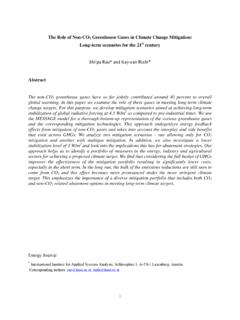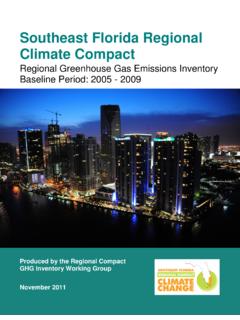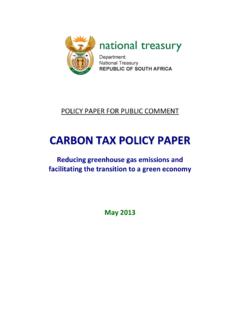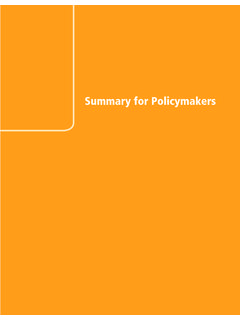Transcription of Policies to Reduce Greenhouse Gas Emissions in …
1 Organisation for Economic Co-operation and Development 2003 International Energy Agency Organisation de Coop ration et de D veloppement Economiques Agence internationale de l' nergie COM/ENV/EPOC/IEA/SLT(2003)2 OECD ENVIRONMENT DIRECTORATE AND INTERNATIONAL ENERGY AGENCY Policies to Reduce Greenhouse Gas Emissions in Industry - Successful Approaches and Lessons Learned: Workshop Report OECD and IEA Information Paper COM/ENV/EPOC/IEA/SLT(2003)2 2 FOREWORD This document was prepared in May 2003 by the OECD Secretariat for the Annex I Expert Group on the United Nations Framework Convention on Climate Change. The Annex I Expert Group oversees development of analytical papers for the purpose of providing useful and timely input to the climate change negotiations. These papers may also be useful to national policy makers and other decision-makers.
2 In a collaborative effort, authors work with the Annex I Expert Group to develop these papers. However, the papers do not necessarily represent the views of the OECD or the IEA, nor are they intended to prejudge the views of countries participating in the Annex I Expert Group. Rather, they are Secretariat information papers intended to inform Member countries, as well as the UNFCCC audience. The Annex I Parties or countries referred to in this document refer to those listed in Annex I to the UNFCCC (as amended at the 3rd Conference of the Parties in December 1997): Australia, Austria, Belarus, Belgium, Bulgaria, Canada, Croatia, Czech Republic, Denmark, the European Community, Estonia, Finland, France, Germany, Greece, Hungary, Iceland, Ireland, Italy, Japan, Latvia, Liechtenstein, Lithuania, Luxembourg, Monaco, Netherlands, New Zealand, Norway, Poland, Portugal, Romania, Russian Federation, Slovakia, Slovenia, Spain, Sweden, Switzerland, Turkey, Ukraine, United Kingdom of Great Britain and Northern Ireland, and United States of America.
3 Where this document refers to countries or governments it is also intended to include regional economic organisations , if appropriate. ACKNOWLEDGEMENTS This workshop report was prepared by Stephen Bygrave and Jane Ellis from the OECD. It revises and expands the workshop background paper prepared by the same authors, to take into account the presentations, discussions and conclusions of the workshop. The authors thank Jan Corfee-Morlot, Nils Axel Braathen and Nick Johnstone from the OECD and Jonathan Pershing and Richard Baron from the IEA, as well as Heino von Meyer and Doug Russell for their input and advice on an earlier version of the paper. The authors also thank Paul Curnow (Australia), Satender Singh (Canada), Erja Fagerlund (Finland), Marcello Balasini (Italy), Erwin Mulders (Netherlands) and Mathias Duwe (CAN Europe), for detailed comments on the paper.
4 Questions and comments should be sent to: Stephen Bygrave OECD Environment Directorate E-mail: Tel: + Fax: + Jane Ellis OECD Environment Directorate Email: Tel: + Fax: + OECD and IEA information papers for the Annex I Expert Group on the UNFCCC can be downloaded from: COM/ENV/EPOC/IEA/SLT(2003)2 3 TABLE OF CONTENTS EXECUTIVE SUMMARY .. 5 1. BACKGROUND .. 7 2. INDUSTRY EMISSION AND POLICY TRENDS .. 8 3. MEASURES OF 10 Environmental 10 Economic efficiency .. 11 Other measures of success .. 11 4. POLICY CONTEXT .. 13 Developing policy packages .. 13 Competitiveness issues .. 15 5. SPECIFIC POLICY INSTRUMENTS AND EXPERIENCE TO DATE IN IMPLEMENTATION.
5 17 17 Carbon/energy 17 Taxes on other gases .. 18 Voluntary approaches .. 19 Voluntary approaches involving government and industry .. 19 Other partnerships .. 20 Experience to date in VA design and effectiveness .. 21 22 Greenhouse gas Emissions trading .. 24 Other trading instruments ..23 Interaction of instruments in the policy mix and 25 6. WORKSHOP CONCLUSIONS .. 28 7. REFERENCES .. 30 8. GLOSSARY .. 36 ANNEX 1: WORKSHOP 37 ANNEX 2: LIST OF PARTICIPANTS .. 40 COM/ENV/EPOC/IEA/SLT(2003)2 4 LIST OF TABLES Table 5: Summary table of range of policy instruments either implemented or planned in selected AIXG 14 Table 6: Energy/CO2 taxes and their use in industry in selected countries .. 18 Table 7: Status of Domestic Emissions Trading Schemes ..23 LIST OF FIGURES Figure 3: Shares of aggregated GHG Emissions in 2000 by sector .. 8 Figure 4: Types of policy instruments to address Greenhouse gas Emissions in industry and the frequency with which they are used.
6 13 COM/ENV/EPOC/IEA/SLT(2003)2 5 Executive Summary The industry sector is an important direct and indirect source of Greenhouse gas Emissions in Annex I countries. It is also a highly heterogeneous sector that has seen both rapid increases and decreases in direct Emissions from different sources over the last decade. Given these trends, the remaining potential for cost-effective emission reductions in industry, and the difficulty in reducing Emissions in other sectors (such as transport), Emissions from the industry sector are expected to draw increasing attention by policy-makers as they look for means to Reduce domestic Greenhouse gas (GHG) Emissions .
7 For this reason, the Annex I Expert Group (AIXG) on the UNFCCC decided to hold a workshop in Berlin on 2-3 December 2002 to discuss the range of Policies to Reduce Greenhouse gas Emissions in industry, with a focus on voluntary approaches (VAs), taxes and trading. The overall aim of the workshop is to assess experience and identify and promote successful approaches, good practice and lessons learned to date. There are two key areas of Greenhouse gas Emissions in the industry sector: firstly, Greenhouse gas (GHG) Emissions from energy use in industry; and secondly, Greenhouse gas Emissions from industrial processes. In Annex I countries in 2000, direct Emissions from the industry sector accounted for approximately 2108 Mt CO2 ( ) of total Annex I Emissions from fuel combustion. Industry also accounted for a similar proportion indirectly from Emissions associated with industry use of electricity1.
8 Process Emissions , Emissions that are caused by the production process, accounted for a further 5% of total Emissions in 23 Parties surveyed by the UNFCCC (UNFCCC 2002a). A wide variation exists in the relative importance of policy instruments used to control GHG Emissions in different countries. To date, VAs have dominated in terms of numbers, with almost every AIXG country having adopted a voluntary approach of one sort or another. Most VAs are energy or CO2-related, although some also cover process Emissions . A range of voluntary approaches have been adopted, varying from voluntary non-binding agreements on reporting Emissions and progress to self-defined targets to negotiated agreements that are legally binding, have benchmarking and performance assessment and contain sanctions in the case of non-compliance. The success of various approaches and policy instruments to Reduce Greenhouse gas Emissions from industry can be measured in different ways.
9 As well as GHG emission reductions beyond a business-as-usual scenario (brought about for example by improvements in energy efficiency), Policies need to be economically efficient and minimise impacts on competitiveness. They also need to be feasible to implement, and provide encouragement to invest in a low-carbon future. Other measures of success could include non-GHG environmental benefits as well as soft measures of success, such as an increased awareness within industry of climate change and potential mitigation actions. In assessing areas for possible future progress, it will be important to take a holistic view of industry Emissions , which may require taking a broader look at how Emissions can be reduced. Thus, the whole production chain may need to be examined, as may issues related to product modifications (rather than focusing on reducing Emissions from a part of the production system).
10 A number of more or less formal partnerships/agreements to Reduce or limit GHG Emissions from industry have also been developed. These include agreements between government and industry, industry and non-governmental organisations (NGOs), within groupings of industry, or individual declarations by particular companies. 1 Assuming a pro-rata distribution of electricity Emissions to industry use of electricity. COM/ENV/EPOC/IEA/SLT(2003)2 6 Most countries have implemented energy taxes on fuels, some have implemented carbon or energy/carbon taxes, but only one country has implemented taxes specifically targeted at reducing domestic industry process Emissions . Where energy/CO2 taxes have been implemented, some sub-sectors in industry (particularly in energy-intensive industry) have been exempted or the tax rate significantly reduced due to competitiveness concerns where firms are exposed to international markets.

















